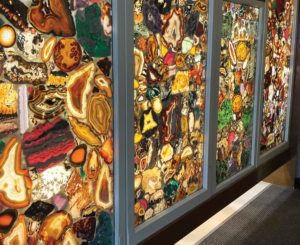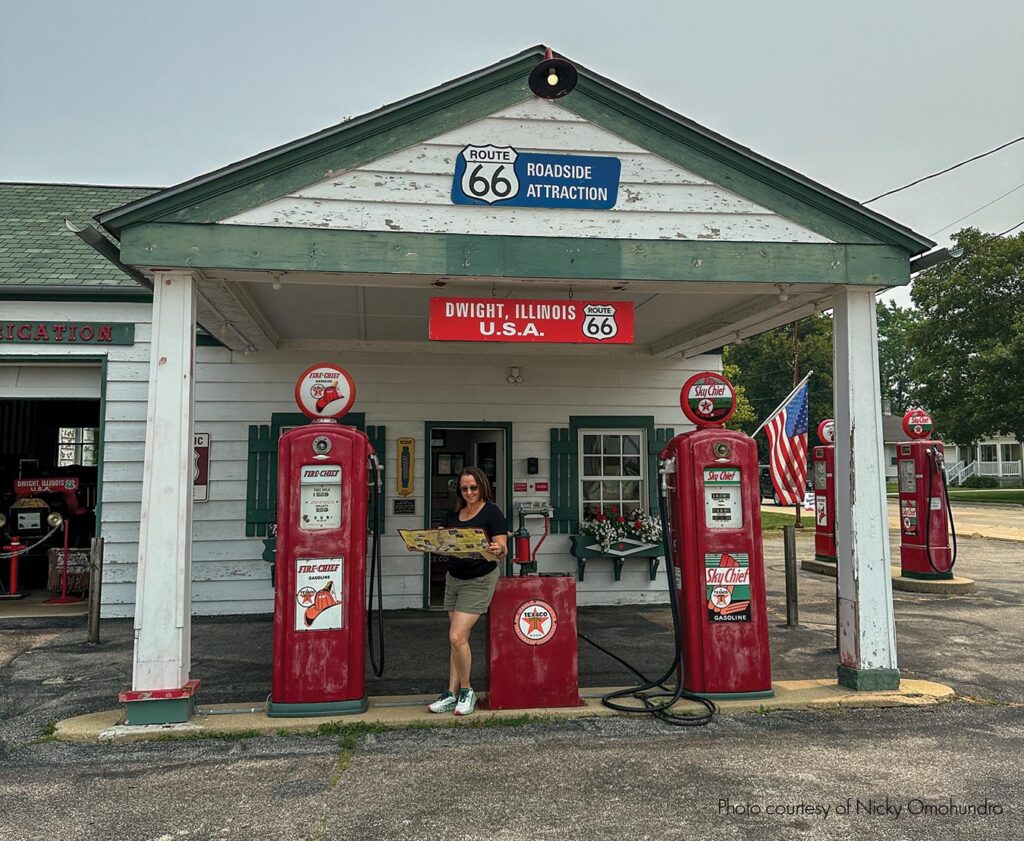Once home to a massive private mineral collection, the Funk Gem and Mineral Museum still houses an impressive geological display at the Funk Prairie Home off the Shirley exit along I-55, about 7 miles southwest of Bloomington.

The collection was assembled by LaFayette Funk II (1897-1992), grandson of Marquis De LaFayette Funk, who in turn was the grandson of Isaac Funk, a wealthy rancher with a Midwest farming and agricultural empire stretching over 20,000 acres. A member of the Illinois Senate and friend to Abraham Lincoln, Isaac founded Funks Grove in the 1820s; today it’s an unincorporated community in McLean County and a National Natural Landmark site.
The Civil War-era home of Funk Sr. now sits nestled on almost 30 acres and about 100 feet from the mineral museum built in the early 1970s to house his grandson’s ever-expanding collection of rocks and minerals from around the world.
“The Funks have been a prominent family in Illinois for many generations,” says Bill Case, live-in curator of the museum for more than 30 years. “They were not only entrepreneurs, but teachers and very generous humanitarians — the museum has always been free to visit. It contains less than 20% of what LaFayette [Jr.] collected during his lifetime, because he gave the rest away to schools, universities and museums to use in teaching. If reassembled today, it would represent the biggest one-man private collection of minerals in the world.”
LaFayette Jr. first developed an interest in rocks and minerals while accompanying his son on a field trip for a geology class at the University of Colorado Boulder. Observing mineral specimens during the excursion, he quickly discovered a new hobby. As a construction engineer for his father’s seed company, Funk traveled the world helping communities develop better farming techniques and was often unexpectedly rewarded with samples from geological and mining sites.
“When people he was assisting discovered his interest in collecting minerals, he was given access to sites nobody else had, even the Smithsonian,” explains Case. To illustrate, he recounts the story of another occasion, when Funk visited Colorado during the construction of tunnels through the Rocky Mountains.
“They were blasting, and somehow LaFayette was at the site when they hit a vein of rhodochrosite,” says Case, referring to the vivid rose-colored, manganese-based mineral widely used in jewelry and Colorado’s state mineral since 2002. “The engineer told him it would be buried under tons of rock, and LaFayette asked if he could grab some before the explosions were set off. He was given a 5-gallon bucket, a hard hat, and told he had 10 minutes to collect what he could. I’ve had museum people stand here in tears because we have the only raw rhodochrosite from that blast zone on the planet.”
While the museum also holds impressive collections of fossils, dinosaur bones, Native American relics, Civil War antiques, Chinese soapstone carvings, bowls, shells and even an assortment of horse-drawn carriages and sleighs, it’s the massive assemblage of minerals and rocks that draws visitors. Even the building housing the museum, unassuming at first glance, is remarkable.
Its exterior walls are coated with 30 tons of rocks embedded in concrete, such as black hornblende, quartz and mica, that Funk transported from North Carolina. If illuminated with mercury lamps, the reflective minerals in the rocks produce an eerie evening glow.
Approaching the entrance, either side of the doorway is straddled with chunks of iron-infused petrified wood that Case delights in tapping to produce unexpectedly high-pitched notes, the product of what he calls a “rock xylophone.” Proceeding through the front door, the diversity of the mineral world is displayed in a single floor-to-ceiling wall comprised of hundreds of illuminated translucent slabs of colorful minerals.
All painstakingly cut by Funk with a diamond saw and sandwiched between two sheets of glass, mineral slivers of green zoisite from South Africa and red corundum rubies, as well as fluorite, agate, chlorite, jasper and more are framed in wood from an old door that Lafayette obtained from a garage sale. “It’s probably the only display like it anywhere on Earth,” says Case.
Once inside the main area, wall-to-wall shelves display thousands of mineral samples of every color, shape and size imaginable. Themed glass-protected cabinets fill the room with more samples. A case of fluorite specimens presents a dazzling variety of colors, many from nearby mines in southern Illinois. Fluorite, a natural form of colorless calcium fluoride, can exhibit a range of colors depending on several factors, including the presence of trace elements.
 Another case is stacked with dozens of shiny samples of pyrite (Fool’s Gold), a brass-colored mineral featuring characteristic cubic crystals comprised of iron and sulfur. There’s also an entire case of native copper; a collection of copper minerals, such as azurite and chrysocolla in all shades of blue; a case of wulfenite (lead molybdenite), with its striking shades of yellow, orange and brown; and an entire room filled with fluorescent rocks that glow under ultraviolet light.
Another case is stacked with dozens of shiny samples of pyrite (Fool’s Gold), a brass-colored mineral featuring characteristic cubic crystals comprised of iron and sulfur. There’s also an entire case of native copper; a collection of copper minerals, such as azurite and chrysocolla in all shades of blue; a case of wulfenite (lead molybdenite), with its striking shades of yellow, orange and brown; and an entire room filled with fluorescent rocks that glow under ultraviolet light.
While much of the collection remains protected behind glass, hundreds of samples remain within reach of even the smallest curious hands. “Everything in the building that’s not behind glass is touchable,” says Case. “Teaching was very important to LaFayette, so he wanted visitors, especially children, to have direct access to many of the samples on display.”
In addition to the collection itself, it’s noteworthy that Lafayette only began gathering minerals in his early 50s. The tales surrounding his collecting expeditions could have formed an intriguing book.
“With his extraordinary mind and photographic memory, LaFayette could go days with only a few hours’ sleep,” says Case. “Despite living to age 94, it’s heartbreaking [that] he succumbed to Alzheimer’s and his memory slipped away before he could document the stories behind his mineral collecting adventures.”
Long after his passing, LaFayette Funk’s dedication to the collection, preservation and display of geological specimens continues to be evident in the gem and mineral museum bearing his name. It awaits all visitors desiring to learn about the rocks and minerals that have shaped our planet.









